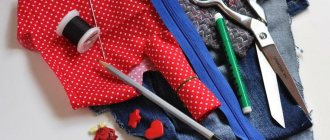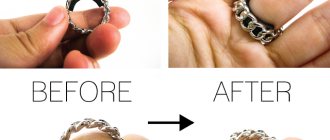How to narrow jeans without a sewing machine
- After putting on jeans, with one hand, pull the trouser leg to the desired width.
- Holding the fabric, wrap all the excess to one side.
- You can secure the fabric by tucking the bottom of the trousers. Depending on the length of the product, one or two folds are made.
- Stand in front of the mirror and evaluate your work. If you like it, do the same procedure with the other pant leg.
- You can adjust the result by experimenting with the height of your trousers.
Work algorithm
The work steps may vary depending on where you need to remove excess fabric. Typically tapering is required at the waist or bottom. How best to sew wide jeans at the waist - by hand or by machine - is not so important. The main thing is to follow the step-by-step instructions, which are suitable for both denim breeches and shorts.
The easiest way:
- Several darts are marked in the waistband area, which are then carefully torn off.
- Next, the darts are stitched (by hand or with a machine).
- The remaining material is cut off and the belt is sewn back.
Narrowing at the waist
It is worth remembering that if you have any doubts about working with clothes yourself, you can always contact a studio. There, wide trousers will lead to the desired style quickly and efficiently. In some cases this is indeed the right decision. For example, this applies to very expensive things that you don’t want to ruin when sewing. Prices in the studio vary depending on the city and prestige. Typically, the service of sewing up trousers costs the client 400-600 rubles.* It all also depends on where the excess fabric needs to be removed. You can contact the studio if you don’t have an overlocker or machine at home - processing will cost 50 rubles/m.
Along the side seams
Stitching along the side seams is used when the trouser legs are wide at the very bottom, at the calves and slightly above. Typically, flared trousers that do not like the shape, and trousers that do not fit, are processed.
How to sew jeans in the legs - the following algorithm will tell you:
- First, you need to try on the jeans to understand where to sew them in and how much. Selected places are secured with pins.
- It’s worth checking again before altering how the item fits your figure.
- Place the jeans on a hard, flat surface and straighten them well so that there are no creases left anywhere.
- Using a bar of soap, draw a line for the future seam at the place where the pins are attached.
- Threads are used to sweep away excess fabric onto items.
Sewing flared trousers
- The pants are tried on again to check for any flaws. It is worth noting that if the jeans are long, they are first shortened to the desired size (but not stitched), and only then the excess is removed from the sides.
- Excess fabric is cut off, leaving an allowance of 1-2.5 cm.
- Then the edges are processed using an overlock or zigzag stitch. The thread is selected according to the shade of the jeans. Edge processing is necessary because... cut fabric quickly deteriorates and crumbles.
- After processing, they begin to sew new seams, carefully connecting them with the old ones.
- The product is ironed and tried on.
How to make skinny jeans from wide jeans - step-by-step instructions
The first step is to prepare the materials.
You will need:
- special threads for denim (for thin jeans – No. 50–60, for thick jeans – No. 30–40);
- needle No. 100;
- scissors;
- a set of tailor's pins;
- ruler;
- chalk or piece of soap.
Regular sewing threads will not work. They will quickly tear, and all the work will be in vain. The color of the threads must be matched either to the tone of the fabric or to the threads with which the product is stitched.
Marking the unnecessary
Before cutting your jeans, you need to decide where and what to remove. It would be correct to sew the trouser legs on both sides, that is, take the fabric from both the inside seam and the side seam. This way the pants won't get skewed. In rare cases, jeans are tapered only along the side seam (when up to 2 cm of fabric is removed).
How to correctly mark the desired width:
- Turn the jeans inside out and put them on.
- Grab the fabric with your fingers and pin it in places where you need to sew it.
- Carefully remove your pants.
- Using a ruler and a sharp bar of soap, draw a line along the pins. Make sure that the transition from the factory seam is smooth.
- Add 0.5-1 cm and draw another line. The jeans will shrink. In addition, the reserve is necessary so that the trousers are comfortable to take off and put on.
We recommend: How to remove strings on clothes without making things worse?
Another way to measure the excess is to place old skinny jeans on the jeans that need to be tapered and trace them with chalk. However, it is less accurate. All pants fit differently, some stretch less, others stretch more. In any case, it is recommended to try on the altered product before cutting anything off.
Basting and trying on
Many people skip the next stage - and make a huge mistake. As they say, measure twice, cut once. If you want your jeans to fit perfectly, first baste them along the second line and try them on. Walk around in them, try to sit down, bend over. If you are comfortable and comfortable, move on to the next step. If not, adjust the basted seam.
Cut and stitch
According to the rules, when sewing trousers, the entire seam is ripped out. But for beginners it’s better not to take risks.
- 5 ways to stretch jeans at home
Do the following:
- Leave 0.5 cm from the factory seam and 1 cm from the basted stitch.
- Trim off excess fabric.
- Sew, going over the factory seam. Sew the bottom of the jeans all the way to the hem.
- Use a serger or zigzag stitch to reinforce the seam.
Topstitching
Typically, denim trousers have stitching - a decorative seam on the front side of the product. When you decide to taper your jeans, it is usually cut off. To return the product to a neat appearance, you need to re-stitch. To do this, threads are selected to match the existing color, and the jeans are stitched at the bottom of the front side in two straight lines.
How to suture yourself
The ability to independently alter things and design clothes is a valuable skill for a modern person. Sewing trousers is not very difficult and you can cope with the task at home, but for this it is important to know a few nuances.
Before and after
Reduce pants at the sides and waist
If trousers need to be reduced literally by 1-2 sizes, there is no need to recut them. It is enough to simply sew the product along the internal seams, capturing 0.5 - 1.5 cm on each side. This option is only suitable if the pants, in principle, fit normally on the figure, but require minor adjustments.
How to sew in trousers on the sides and in the waistband
To sew a garment correctly, you first need to take measurements and try them on for your figure. The easiest way is to mark the desired width on the sides, make marks with chalk or thread and stitch.
Note! This method is not suitable if you need to reduce your pants by more than 3 sizes. Then it is necessary to reshape them, that is, rip them apart and sew them again.
Adjustment only on the sides
When the pants fit perfectly at the waist, but are a little too big in the hips and legs, they can be sewn in only on the sides, without curling the belt. To do this, you need to put the product on yourself and determine where to start narrowing. In order not to miss (especially for beginners), it is recommended to first baste the pants, try them on, and then sew them in with a machine.
- Try on the trousers and determine the stitching width. For convenience, you can mark with chalk or a needle and thread.
- Lay the product on a flat surface; if you don’t have a large table at home, you can lay it on the floor.
- Using a centimeter or ruler, measure the same distance from the outer seam along the entire length of the galoshes.
- Next, try on, and if everything fits, then stitch, trim off the excess and process the cut.
- It is important to iron the new seam at the end so that there are no wrinkles on it, especially if these are classic trousers and not stretch or denim.
Taper on the sides of the trousers
Reducing your waist without a sewing machine
Do your jeans fit perfectly on your hips, butt and legs, but hang out a little at the waist? - This is not a problem; it can be solved quickly, even without using a sewing machine. If you need to remove a few centimeters from the waistband of your jeans, then a wide elastic band will come to the rescue. It is necessary to cut off about 7 cm of elastic and sew it inside out from the middle of the waistband, stretching it greatly. When she pulls herself into her usual position, she will pull the belt along with her, which will become a little smaller and will no longer stick out on her figure.
The second option for sewing jeans is darts on the back sides. This option is perfect for any model of denim trousers - women's and men's. You need to carefully rip off the belt, make darts, then cut off the extra centimeters from the belt and sew it back. All this can be done without a machine. The work takes on average about 2 hours.
Back darts on jeans
Sewing in the waistband of trousers with an elastic band
Pants with an elastic band cause fear among many if they need to be reduced in size a little. There's nothing wrong with it. First you need to remove the elastic band and rip off the belt, and then sew the product in any convenient way:
- side seams (which are on the outside);
- if the belt is sewn in front and back, then it is better to sew the trousers along the middle seam;
- internal seams (professionals call the internal seam a step seam).
Important! You should not sew pants with an elastic band using darts, this will only ruin the product.
Regardless of where the item is sutured, the algorithm of actions is almost the same:
- first you need to decide which side the seam will be sewn on;
- the next step is to undo the belt;
- then you need to turn the product inside out and secure the excess fabric with pins;
- a new seam is laid, excess tissue is cut off, and the cut site is processed;
- The last step is sewing the belt into place.
Finally, it is important not to forget to iron the new seam.
Seam on trousers with elastic band
Sewing sweatpants to size
The main feature of sweatpants is the material from which they are made. If it is stretch, then it has the ability to shoot arrows and it is better to sew it in the atelier of a master. If it is possible to reduce your sweatpants at home, then you can use one of the following methods:
- If the pants fit well on the hips and are not low-rise, you can sew them in along the inside (inseam) seam. To do this, you need to turn the product inside out and mark the desired width with a ruler. It is important that it is the same everywhere, then fix it with needles, lay a basting stitch, measure it and stitch it.
Advice! When stitching on a machine, you should not stretch the fabric, because the result will be seams with wrinkles and folds that cannot be smoothed out later.
- If you need to sew the pants along the entire length, taking into account the belt, then it is better to do this along the side seams. This way, new seams are laid that will not be noticeable when worn.
If the tracksuit is made of jersey, then you need to use a thin needle so as not to break the fabric and cause arrows to appear.
Making fashionable jeans
If you want to not only narrow your jeans with your own hands, but also make them more fashionable, you can insert a strip of leather, lace or mesh, or a zipper into the side seam, so you will give ordinary jeans an original look. To do this: turn the jeans inside out and measure the places that need to be sewn in on both sides of the legs. Remove the jeans and draw seam lines along the marks you made. After stitching the legs, draw lines along which to trim off the excess, make seam allowances of 1-1.5 cm, cut off the excess fabric. Cut out a strip from any fabric you like (leather, lace or a regular zipper). The pattern should be in the form of a triangle with a base of 5-10 cm and a height equal to the distance from the narrowing point to the bottom of the trouser legs. Insert strips of fabric into the legs and stitch them down. Process the bottom of the trousers.
How to taper jeans at the bottom at home without a sewing machine
Everyone is chasing fashion and trying to look beautiful, youthful, but what to do if you want to make your jeans skinny at the bottom, but you have no experience with a sewing machine, and you don’t even have a machine, try the simple method by folding excess fabric on the legs. This method of tapering pants will take a few minutes, you need to proceed like this:
- Put on your jeans, stand in front of the mirror;
- Pull one trouser leg to the required width with one hand;
- Holding the trouser leg with the fingers of one hand, fold the excess fabric to the right or left, as convenient for you, with the other hand;
- Fold the bottom of the jeans once, securing the folded fabric;
- You can wrap the bottom twice if the length allows;
- Evaluate the result - if you are satisfied with this width, then do the same steps with the other pant leg;
- Experiment with the height of the trousers and their width until you achieve the desired result.
When is it better to redraw
Recutting is needed when the trousers require not a superficial correction, but a complete alteration. That is. If they need to be changed several sizes, change the shape and fit. In fact, this process involves ripping out old trousers and sewing new ones.
Re-cutting requires at least minimal skills in cutting and sewing, otherwise it is unlikely that you will get a good product. If you have no experience, then it is recommended to contact a specialist or train on pants that you don’t mind ruining. All skills come with experience.
First, the old trousers need to be completely ripped apart. This is done at the seams; it is better not to use scissors, but to use a special tool - a ripper.
Then you need to remove all the threads, iron the seams and mark new ones. The second option is to use a pattern that will be used to sew new trousers from the old material. Making a pattern is not easy for a novice craftsman, so it is better to use a ready-made one (download from the Internet).
Reshaping
The article discusses how to sew pants a size smaller and recut them if you need to significantly change the size of the item. In fact, there is nothing complicated and even a beginner who has never sewed can cope with the task. It is important not to forget about the well-known proverb “measure twice, cut once.”
Source
Tapering jeans at the side seams, topstitching
- Measure the desired width along the bottom of the trouser leg. We use chalk to mark the inside and side seams.
- We draw a straight line from the knee or from the hip (depending on the style of your jeans and your desire) to the mark at the bottom of the leg.
Side seam, topstitching
- Unmask the side seam. If there is stitching along the side seam, then rip out both the stitching and the side seam.
- We sweep along the chalk lines. Let's sew. We start stitching 3-4cm above the cut, combining the beginning with the old stitch to make the transition smooth.
- Let's overlock. If you don’t have an overlocker, then step back 1.5 cm from the laid line, draw a line with chalk and cut off the excess with scissors. We process the edges with a zigzag.
Denim fabric is quite loose, so it is necessary to process the edges. The stitching can also be done in a studio.
- We thread the thread into the machine to match the stitching. We lay the finishing stitch so as to imitate the factory one.
- Carefully select the stitch length so that your stitching looks like an organic continuation of the factory one. The thread on top should be thick. You can thread two threads of the same color if you don’t have a thick thread on hand.
- Ironing the seams.♦For the work to look neat and professional, each newly sewn seam must be ironed.
Inseam
- We combine the cuts of the jeans along the inner seam. Baste, stitch and overlock the inner seam.
- Iron the jeans along the inside seam.
How to sew pants correctly
Depending on the desired effect, adjustments are made in different areas. But there are general rules:
- before starting work, the trousers are ironed from the wrong side, paying attention to the seams, and the joints are smoothed out in the process;
- make marks and draw lines on the product with chalk or a special washable marker so that they are clear;
- the transition line from the old seam to the new one should be smooth;
- allowances are left - 1 cm;
- First you need to do basting and fitting to make sure the pants fit, and then machine stitching.
To properly sew in trousers, you should not chop off excess fabric when putting the item on inside out - puffy pockets and seams will not allow you to objectively assess where and what excess needs to be removed; it is better to chop them off with needles from the front side, and then transfer the marks to the wrong side.
How to sew wide trousers in the waist and sides
If the trousers are wide at the waist and hips, the following measurements are needed: waist, hips, height of the area being sutured (along the side seam). To make pants with belt loops, jeans or men's pants smaller, use this method:
- The belt is peeled off from the side so that it is convenient to carry out further manipulations with it.
- The side seams are ripped out to the marked point from which the narrowing begins.
- The belt is cut on each side under the adjacent belt loops so that they completely hide the junction. If there are no belt loops, the belt is cut so that the joint is located exactly above the side seam.
- The parts are ground down and excess fabric is cut off.
- The upper part of the belt is connected along the old lines, and the lower part is attached to the trousers in the same way as they were sewn.
To sew the trousers in the belt, it can be completely cut off and shortened. The excess width in the waist area is taken into the side seams, and then the belt is sewn in.
Correcting the middle seam
The middle seam is also called the elephant seam and the seat seam. Its adjustment is considered simple and therefore, in order to narrow trousers, this method is used most often:
- Exactly in the middle of the back, on the front and back sides of the product, draw a vertical line on the belt, as if continuing the seam line, and mark the segment that needs to be picked up.
- Rip off the belt loop and belt (about 8 cm on each half) and remove the decorative stitching, if any.
- Cut the belt along the marked line.
- The seam and waistband are sutured, excess fabric is cut off, the finishing stitching is restored and the waistband is attached.
It is recommended to take no more than 3 cm from each back half.
How to sew pants only on the sides
If the trousers are too big in the buttocks and hips, and the belt fits well, it is enough to sew in the trousers on the sides:
- Put on your trousers and measure and pin off any excess fabric in front of the mirror.
- If the new stitch line runs near the rivets, they must be removed.
- Baste the seams, try them on, and if you are satisfied with the result, machine stitch them.
- Trim off excess fabric and finish the edges with an overlocker or zigzag stitch.
How to sew wide-leg trousers along the entire length
To sew in wide trousers, put them on and, pulling the fabric, pin off its excess with pins on both sides. Move from top to bottom, achieving the desired fit to the figure. Then:
- The trousers are turned inside out and on the wrong side, the points where the needles are inserted are marked with small pieces.
- The needles are taken out.
- Rip out the hem partially or completely if the trouser legs are narrow.
- Using chalk and a ruler, apply a new stitching line to one pant leg.
To ensure that the trouser legs are the same, the contour of the new seam is transferred from one half to the other like this:
- the trousers are folded and the side edges of both halves are folded exactly into the old seam;
- connect with needles along the new contour;
- turn it over and on the other trouser leg, focusing on the needles, draw a stitching line.
Before stitching the parts, they are cut crosswise to protect the fabric from shifting. After stitching, fold the bottom.
How to properly sew women's bell-bottom trousers
If it is enough to sew in bell-bottom trousers by 2 cm, this is done along the inner seam. Flares can be turned into straight ones by tapering them from the hip or knee. If more than 2 cm needs to be removed, both sides of the trouser legs are sutured:
- measure the total length of the piece of fabric that needs to be removed;
- turn the trousers inside out and lay them aside on both sides of the joints (inner and outer) along half of the segment;
- draw straight lines from both marks up to the intersection with the seam and sweep away.
It is convenient if there is a model that can be taken as a sample. When you apply it to pants that need to be altered, you can immediately see where and how to sew in the pants, and in which places you need to take more.
How to sew pants at the bottom
You can sew in pants that are loose at the hips or have a classic cut by narrowing them at the bottom and turning them into banana or cigarette pants, for this:
- tear off the hem;
- specify the length of the product, taking into account that models that sharply taper at the bottom are 3-4 cm shorter than the classic ones;
- to determine the width of the legs at the bottom, measure the girth of the ankle, add 7-10 cm, divide by 2, and place the resulting segment in the center of the bottom edge.
The details are narrowed sharply, at a distance of 18-24 cm from the bottom, and 6-8 cm from the edge are measured vertically (3-4 cm of which will go to the hem). If you need to sew the trousers at the bottom, it is important to ensure a loose fit around the knee.
How to make your trousers 1-2 sizes smaller
In this case, excess fabric is removed along all seams except the fly, because the middle edge of 2 adjacent sizes is almost the same. After putting on the pants, the excess is pinned off. After the lines of all new seams have been applied to the wrong side, they are basted, turned inside out and tried on. If necessary, one or another line is adjusted, and when the desired result is achieved, the factory lines that are subject to change are ripped out, and then ground along the outlines in the following sequence:
- elephant;
- lateral;
- stepper vertical;
- shortening the belt.
Having stitched 1 seam, cut off the excess fabric and overcast the edges, and then proceed to the next operation. Before sewing on the waistband, you need to try on the trousers, because when altered to a size smaller, it may be necessary to adjust the line of its sewing. When sewing up more than 2 sizes, the pants are completely ripped out and recut.
Features of working with arrows
To prevent the arrows from becoming skewed when changing the width of the trousers, it is necessary to ensure that the side edges match. The arrows divide the front and back halves of the pants in half approximately to the level where the parts begin to round. Therefore, the side and step seams are sutured symmetrically. After hand basting, fitting is required.
Required Tools
One of the prerequisites for fast and high-quality work on how to narrow jeans from the bottom at home is the preparation of tools and materials.
For work you will need:
- sewing machine (preferably electric);
- overlock (if you don’t have one, you can use a zigzag stitch);
- tailor's scissors are the most suitable option for thick denim;
- tailor's chalk (you can use a sharpened piece of soap);
- iron (it’s good if it has a steam function);
- threads;
- sewing needles;
- long wooden ruler, measuring tape;
- ironing board.
- How to dye jeans blue or black at home. Step-by-step instructions with photos
Model preparation
Before you start sewing jeans, you need to prepare the model for work. Pants can be hemmed not only from the bottom, but also in other places where it is necessary. If the goal is to narrow the item at the bottom, then the product is turned inside out and the bottom seams are ripped out, which are then ironed well.
It is worth noting that both women's and men's pants are sewn according to the same principle. The final result will depend only on the preferences of the person himself.
Note! The following life hack may help - before sewing in jeans at the waist, they should be washed at least once. This will prevent things from “settling” in the future.
Ironing things
Preparation for sewing at the hips consists of cutting the side seams (which are located higher), and to reduce the waist, the item is unzipped from the back. When ironing, special attention should be paid to the seams, so that later it will be easier to work with them. When cutting, it is important to be careful not to cut off too much or make a crooked line.
The following tips may be helpful when sewing:
- During work, you should try on the item several times to make sure there are no inaccuracies.
- If you have trousers in your wardrobe that match the required style, you can use them as a template.
- Don't rip your pants completely. Seams in the crotch area are quite problematic to sew on your own, especially for beginners.
- It’s worth specially purchasing strong threads if you don’t have them. Thin ones can tear at any moment, and all the work will be ruined.
- It is recommended to process the cut edges with an overlock or zigzag stitch, as denim tends to fray, and this will cause the item to suffer when worn.
How much does it cost to have jeans tapered at a tailor?
If you want the work to be done as efficiently and quickly as possible, but you don’t have the necessary skills yourself, then you should think about taking the item to a studio. The same should be done if we are talking about branded, expensive clothes that you are afraid of being ruined by unprofessional actions.
The cost of the service will depend on the status of the establishment, the required volume and speed of work. Sewing jeans along the middle seam will cost about 400 rubles, and at the side seams - 600 rubles. The need for finishing stitching increases the cost of work by an average of 50-70 rubles. Shortening trouser legs will also cost about 300-400 rubles.
A combined option is possible. For example, you firmly believe that you can tape your jeans to a high quality on your own, but you don’t have a serger at home. Then the product can be taken to the studio only for edge processing, and everything else can be done on your own. This is a very economical way out. 1 meter of processing costs about 50 rubles.
Video: how to narrow your jeans yourself without a sewing machine?











